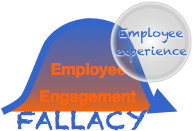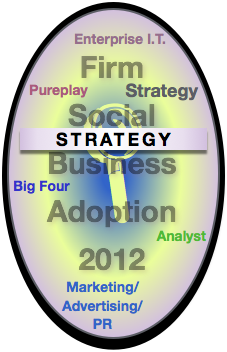 [Updated] Ethnographic research of social media is one of my biggest secrets. It has become the foundation of CSRA’s ability to create trust at scale, so here I’ll share how I came to use it with social media. Then I’ll explain what ethnographic research is, why it’s vital to CSRA, and how it works, so you can use it. Finally, I’ll share use cases for experiential social media, product management, business innovation, and cross-border business. [Updated] Ethnographic research of social media is one of my biggest secrets. It has become the foundation of CSRA’s ability to create trust at scale, so here I’ll share how I came to use it with social media. Then I’ll explain what ethnographic research is, why it’s vital to CSRA, and how it works, so you can use it. Finally, I’ll share use cases for experiential social media, product management, business innovation, and cross-border business.
[…]
 The Employee Engagement Fallacy reveals that most literature, papers, and methods are built on faulty Industrial Economy employment attitudes, and it provides an approach that uses experiential social media to help reframe employment and performance. The Employee Engagement Fallacy reveals that most literature, papers, and methods are built on faulty Industrial Economy employment attitudes, and it provides an approach that uses experiential social media to help reframe employment and performance.
Although the idea of “employee engagement” can be a rare opportunity to increase competitiveness, its practice is compromised by well intended but flawed logic.
Here’s the fallacy: Employee “engagement” is the result of employees’ experiences while they’re working at employers. Few engagement programs focus on employees’ experiences, so they fall short.
Engagement is not achieved by a program or initiative that focuses on the outcome. Employers see much more success at achieving the result when they focus on empowering the experiences their employees want when they decide to work at the employer. Experience is the motor of engagement, so empowering experience is the first step of raising productivity and lowering employment costs, two common employee engagement goals. Here’s how it’s done.
[…]
 [UPDATED] Strategy firms are the most trusted names sought by CEOs and boards of directors who are reevaluating their companies’ identities, strategies and operations. Strategy firms have been making measured investments in social business over the last few years. Their knowledge of enterprise transformation is deep and broad, and they all have proprietary methodologies for most aspects of the strategy and transformation life cycle. They have deep and broad expertise in market analysis, competitive analysis corporate core competency analysis and virtually all aspects of operations. Many firms have large business transformation practices that explicitly guide clients through profound redefinition and change. [UPDATED] Strategy firms are the most trusted names sought by CEOs and boards of directors who are reevaluating their companies’ identities, strategies and operations. Strategy firms have been making measured investments in social business over the last few years. Their knowledge of enterprise transformation is deep and broad, and they all have proprietary methodologies for most aspects of the strategy and transformation life cycle. They have deep and broad expertise in market analysis, competitive analysis corporate core competency analysis and virtually all aspects of operations. Many firms have large business transformation practices that explicitly guide clients through profound redefinition and change.
Strategy firms have extensive core competencies that could enable them to offer social business strategy services. In addition, Strategy firms are significant producers of thought leadership relevant to corporate and business strategy as well as operations. Most firms field high quality management journals whose papers are written by their consultants. Many have research boutiques or even full-fledged businesses for research and thought leadership. However, they are challenged by very conservative […]
 [UPDATED] Analyst firms are go-to sources for emerging business and technology trends since they conduct constant due diligence on markets and technologies, which they sell via a subscription model. In addition, they are prodigious producers of content, conferences and other thought leadership activities relevant to social technologies, and a large portion of their employees produce and deliver content publicly (research, write, present), which strengthens their competency with social technologies. [UPDATED] Analyst firms are go-to sources for emerging business and technology trends since they conduct constant due diligence on markets and technologies, which they sell via a subscription model. In addition, they are prodigious producers of content, conferences and other thought leadership activities relevant to social technologies, and a large portion of their employees produce and deliver content publicly (research, write, present), which strengthens their competency with social technologies.
As with most advisory firm categories, market leaders Forrester, Gartner and IDC are being challenged by analyst social business pureplays Altimeter Group and Constellation Research Group, while other firms hang back. This report also includes NM Incite, which is more of a market search firm, but it makes for an interesting comparison.
Advisory and Services Firm Social Business Adoption 2012 is a research survey that evaluates and quantitatively ranks the maturity of agency and consultancy social business practices. The survey ranks Strategy firms, Big Four, Marketing/Advertising/PR agencies, Analysts, Enterprise I.T. firms and Pureplays on their social business practices, service offerings and leadership—specifically […]
 Advisory and Services Firm Social Business Adoption 2012 audits the maturity of management consultancies’ and agencies’ social business practices. It aims to serve CEOs and CMOs who want to maximize the potential value of social business by evolving their organizations. Similarly, it will be useful to firm and agency executives that want to position themselves as strong players in the growing market for social business strategy. Advisory and Services Firm Social Business Adoption 2012 audits the maturity of management consultancies’ and agencies’ social business practices. It aims to serve CEOs and CMOs who want to maximize the potential value of social business by evolving their organizations. Similarly, it will be useful to firm and agency executives that want to position themselves as strong players in the growing market for social business strategy.
This research survey may be unique because it focuses its evaluation on firms’ ability to advise clients on becoming more social by transforming their organizations. It attempts to factor out “social media promotion” since it is usually driven by marketing, not relationship. In addition, this survey quantitatively measures firms’ social business commitment; firms that don’t practice social business themselves cannot be credible advisors.
The Advisory and Services Firm Social Business Adoption 2012 microsite has all information pertaining to the research survey.
[…]
Highlights of Alcatel-Lucent’s recent marketing study of 1,000 social networkers, presented by CMO Allison Cerra at #snc2010: Social networkers are not very social; Heavy users of Web 2.0 will pay for value-added services; Privacy is murky […]
Digital social networks give front row seats in many aspects of human dramas, but few companies or individuals have the understanding of human behavior to appreciate fully what they are seeing. Many executives of commercial and government enterprises perceive “social” behavior as frivolous and discourage employees’ activity in social networks. This exceptional book shows that the separation of “work” and “social” is dangerously out of place today because collaboration produces the lion’s share of business value. To succeed, leaders need to appreciate the importance of social activity in collaboration and productivity, and how digital social networks can increase productivity. […]
The Emerging Global Labor Market: Don’t Panic! calls out leading research from McKinsey Global Institute on global development of many industries.
When the U.S. saw manufacturing companies move significant operations offshore during the 80s and 90s, most people were unhappy, but many understood that certain industries were maturing, facing global competition and price pressures. Consequently, they were forced to remain competitive through lower labor costs. However, as awareness of IT offshoring spread in the context of the Tech Bust in the early 2000s, it sent a chill of fear up and down the collective spine: “How could the high tech juggernaut be outsourced and offshored? Would this development prevent its recovery?” Noisy gnashing of teeth, protectionist legislation and demonstrations. The longer term question was:
As “the world” graduates many more engineers, MBAs and scientists than does the U.S., will they threaten the employment of U.S. high value professionals?
That’s an excellent (and important) question. The McKinsey Global Institute (MGI)published a significant study in June 2005, The Emerging Global Labor Market, in which they reported results of an in-depth analysis of the supply and demand of offshore outsourcing. In short, they found that:
Offshoring will create a “relatively small” global labor […]
|
|
 [Updated] Ethnographic research of social media is one of my biggest secrets. It has become the foundation of CSRA’s ability to create trust at scale, so here I’ll share how I came to use it with social media. Then I’ll explain what ethnographic research is, why it’s vital to CSRA, and how it works, so you can use it. Finally, I’ll share use cases for experiential social media, product management, business innovation, and cross-border business.
[Updated] Ethnographic research of social media is one of my biggest secrets. It has become the foundation of CSRA’s ability to create trust at scale, so here I’ll share how I came to use it with social media. Then I’ll explain what ethnographic research is, why it’s vital to CSRA, and how it works, so you can use it. Finally, I’ll share use cases for experiential social media, product management, business innovation, and cross-border business.
 [UPDATED] Strategy firms are the most trusted names sought by CEOs and boards of directors who are reevaluating their companies’ identities, strategies and operations. Strategy firms have been making measured investments in social business over the last few years. Their knowledge of enterprise transformation is deep and broad, and they all have proprietary methodologies for most aspects of the strategy and transformation life cycle. They have deep and broad expertise in market analysis, competitive analysis corporate core competency analysis and virtually all aspects of operations. Many firms have large business transformation practices that explicitly guide clients through profound redefinition and change.
[UPDATED] Strategy firms are the most trusted names sought by CEOs and boards of directors who are reevaluating their companies’ identities, strategies and operations. Strategy firms have been making measured investments in social business over the last few years. Their knowledge of enterprise transformation is deep and broad, and they all have proprietary methodologies for most aspects of the strategy and transformation life cycle. They have deep and broad expertise in market analysis, competitive analysis corporate core competency analysis and virtually all aspects of operations. Many firms have large business transformation practices that explicitly guide clients through profound redefinition and change. [UPDATED] Analyst firms are go-to sources for emerging business and technology trends since they conduct constant due diligence on markets and technologies, which they sell via a subscription model. In addition, they are prodigious producers of content, conferences and other thought leadership activities relevant to social technologies, and a large portion of their employees produce and deliver content publicly (research, write, present), which strengthens their competency with social technologies.
[UPDATED] Analyst firms are go-to sources for emerging business and technology trends since they conduct constant due diligence on markets and technologies, which they sell via a subscription model. In addition, they are prodigious producers of content, conferences and other thought leadership activities relevant to social technologies, and a large portion of their employees produce and deliver content publicly (research, write, present), which strengthens their competency with social technologies. Advisory and Services Firm Social Business Adoption 2012 audits the maturity of management consultancies’ and agencies’ social business practices. It aims to serve CEOs and CMOs who want to maximize the potential value of social business by evolving their organizations. Similarly, it will be useful to firm and agency executives that want to position themselves as strong players in the growing market for social business strategy.
Advisory and Services Firm Social Business Adoption 2012 audits the maturity of management consultancies’ and agencies’ social business practices. It aims to serve CEOs and CMOs who want to maximize the potential value of social business by evolving their organizations. Similarly, it will be useful to firm and agency executives that want to position themselves as strong players in the growing market for social business strategy.